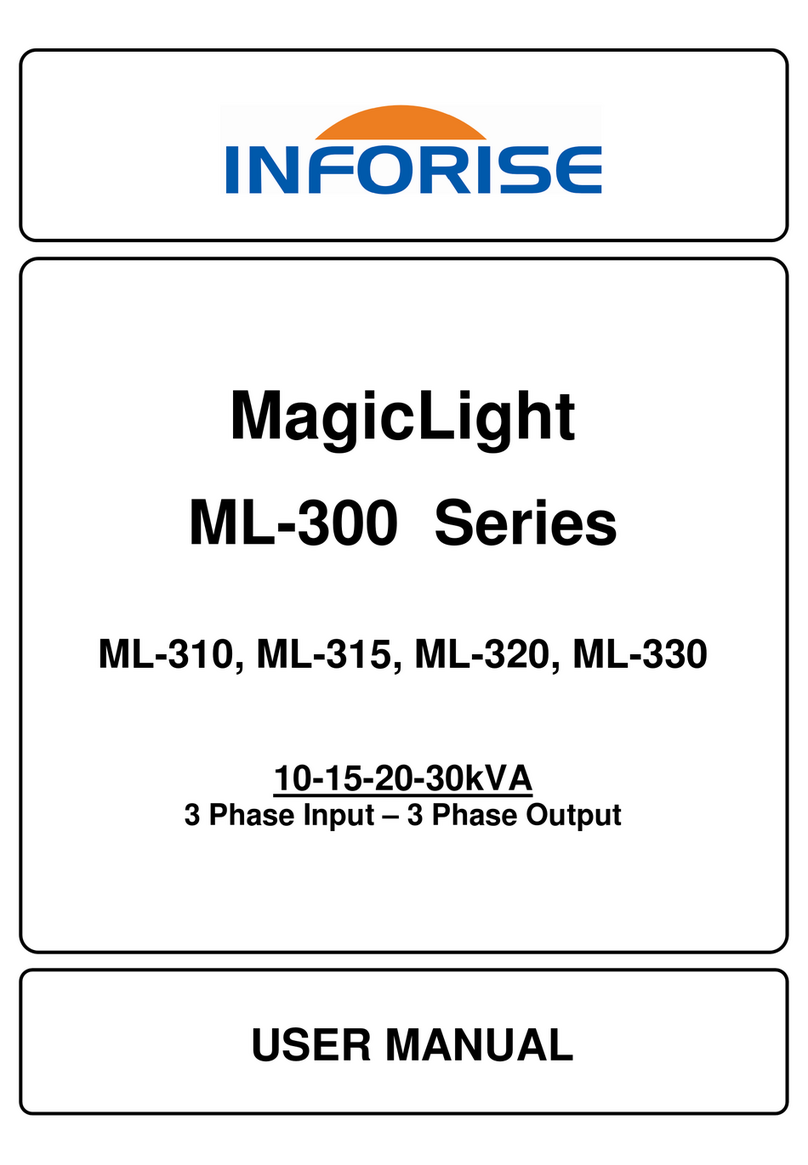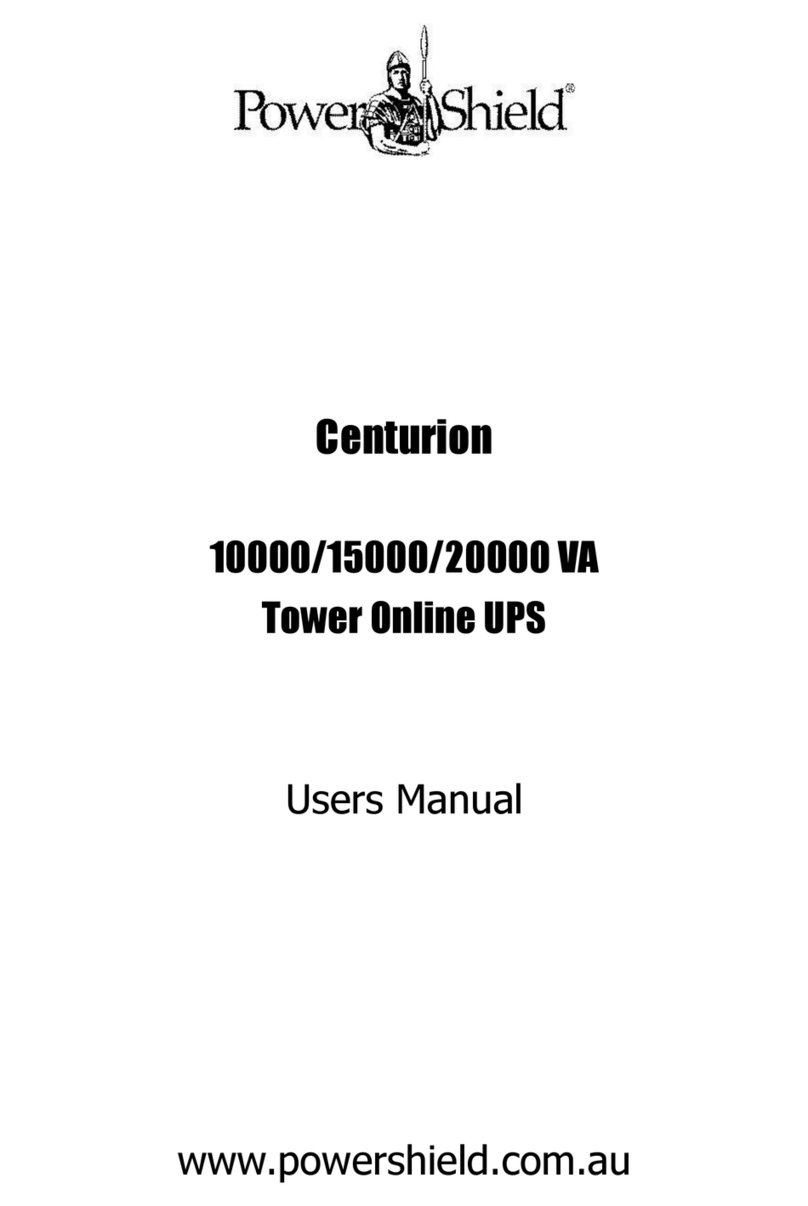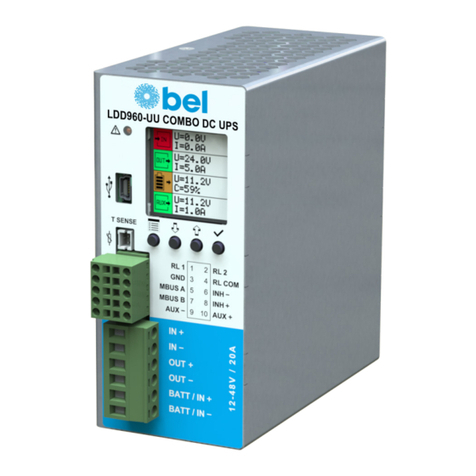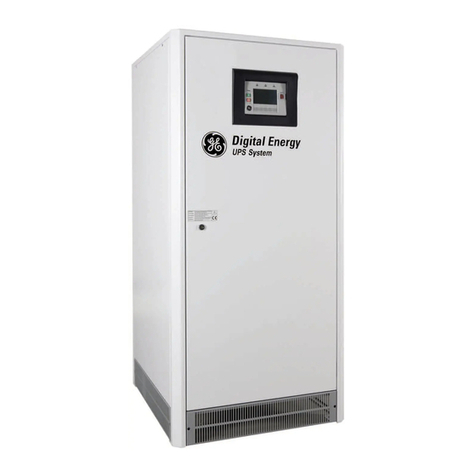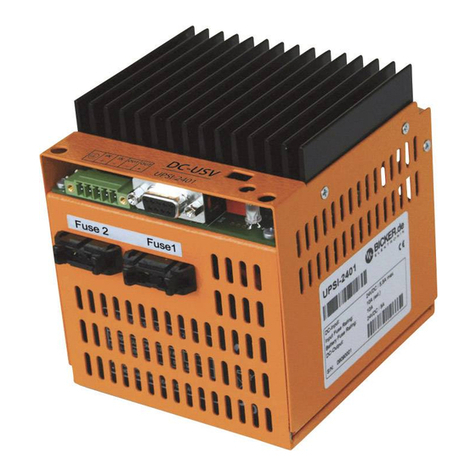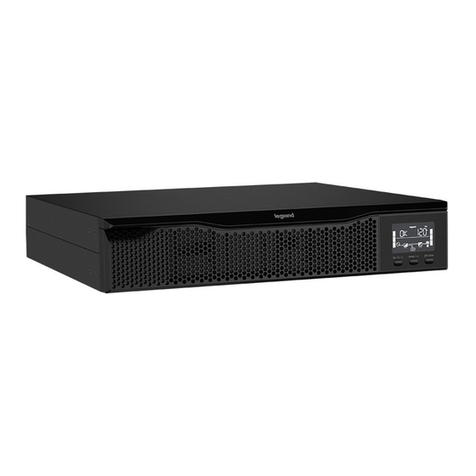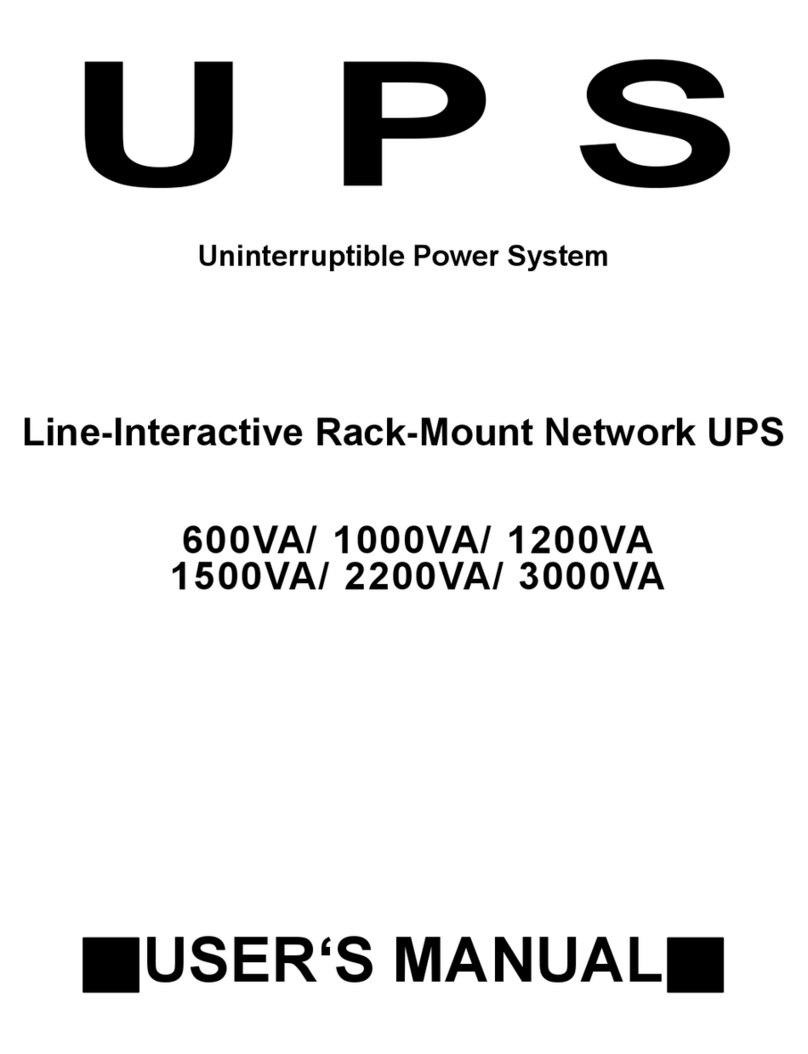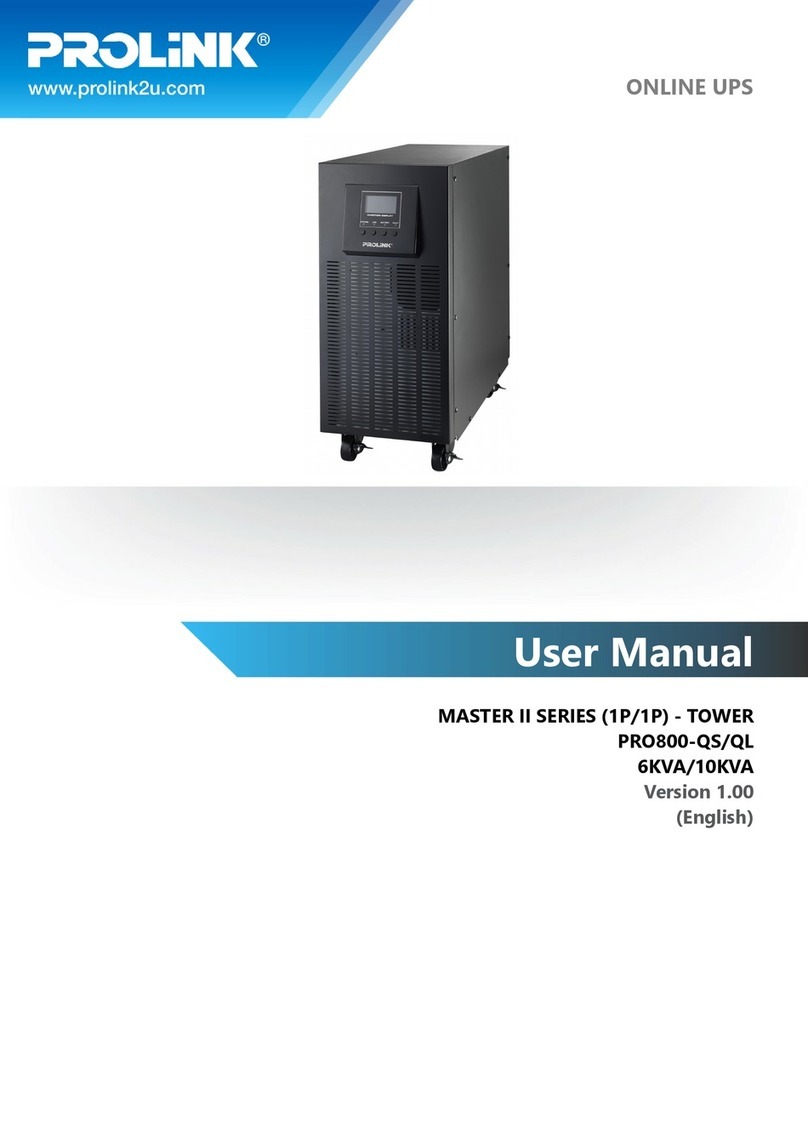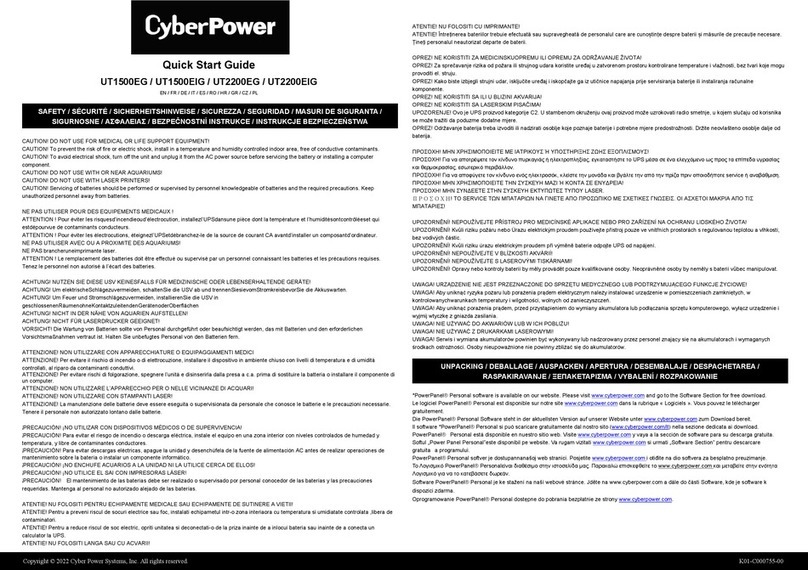INFORISE SunLight-206 User manual

SUNLIGHT SERIES
USER MANUAL
UNINTERRUPTIBLE POWER SUPPLIES
( 3 Phase Input & 1 Phase Output )
info-rise
TECHNOLOGIES
SunLight-206 6 kVA
SunLight-207 7,5 kVA
SunLight -210 10 kVA
SunLight -215 15 kVA
SunLight -220 20 kVA
SunLight -230 30 kVA

1
SunLight Series UPS User Manual
CONTENTS
I. SAFETY..................................................................................2
II. INTRODUCTION
2.1. System Description .................................................. 3
2.2. Technical Specifications .................................................5
III. INSTALLATION
3.1. Unpacking .............................................................. 7
3.2. Location Selection ........................................................... 7
3.3. Cable Connections .......................................................... 7
3.3.1. 6-7,5-10 kVA ......................................................... 8
3.3.2. 15 kVA................................................................... 8
3.3.3. 20-30 kVA..............................................................8
3.4. Start – up ........................................................................9
3.4.1. 6-7,5-10 kVA.........................................................9
3.4.2. 15-20-30 kVA........................................................10
IV. OPERATION PROCEDURE
4.1. 6-7,5-10kVA.....................................................................11
4.1.1. Turn On Procedure ...............................................11
4.1.2. Turn Off Procedure ............................................... 11
4.2. 15-20-30 kVA................................................................... 11
4.2.1. Turn On Procedure ...............................................11
4.2.2. Turn Off Procedure ............................................... 11
4.3. When Utility Power Is Interrupted....................................11
4.4. Operator Control Panel....................................................12
4.4.1. Push Buttons......................................................... 12
4.4.2. First Message Line Of The LCD............................ 12
4.4.3. Second M.L.(ALARMS)Of The LCD...................... 13
4.4.4. FAULT Codes .......................................................14
4.5. Automatic Battery Test System.......................................14
V. OPTIONAL EQUIPMENT
5.1. Software Options ............................................................15
5.1.1. Upsilon 2000 Software..........................................15
5.2. SNMP Module.................................................................16
5.3. UPS DB9 port definition..................................................16
5.4. Remote Monitoring Panel ............................................... 17
5.5. UPS Port Sharer.............................................................17
5.6. RSC24 RS232/RS485 Interface .....................................17
5.7. US-8 Connection Diagram.............................................. 18
5.8. Remote Monitoring Panel Conn. Diagram......................19
VI. CUSTOMER SERVICE
6.1. Maintenance ................................................................... 20
6.2. Troubleshooting..............................................................20
6.3. Storage ...........................................................................20
VII. LIMITED WARRANTY............................................................ 21

2
SunLight Series UPS User Manual
I. SAFETY
This manual contains important instructions for SUNLIGHT series UPS that should be followed during
installation and maintenance.
IMPORTANT NOTICES
1. Read instructions carefully before operating the UPS
2. All warnings in the manual should be adhered to.
3. All operating instructions should be followed.
4. The unit should be supplied by a grounded outlet. Do not operate the unit without ground source.
5. Power cord of the UPS should be routed carefully so that they are not to be walked on.
6. Please save this manual.
7. Please save or recycle the packaging materials.
WARNING!
•Do not insert any object into ventilation holes or other openings.
•To reduce the risk of fire or electric shock, install in temperature and humidity controlled indoor
area free of conductive contaminants.
•To reduce the risk of fire, replace fuses with the same type and rating when necessary.
CAUTION!
•Only qualified personnel should install or service UPS/batteries.
•Risk of electric shock, do not remove cover. No user serviceable parts inside, refer
servicing to qualified service personnel.
•The output may be energized when the unit is not connected to a mains supply.
•Risk of electric shock hazardous live parts inside this unit are energized from the battery
supply even when the input AC power is connected.
•To reduce the risk of electric shock, disconnect the UPS from the mains supply before installing a
computer interface signal cable. Reconnect the power cord only after signalling interconnections
have been made.
ABOUT THE BATTERY
•A battery can present a risk of electric shock or burn from high short circuit currents. The
following precaution should be observed when working on batteries :
* Remove watches, rings or other metal objects.
* Use tools with insulated handles.
•The batteries in this UPS are recyclable. Batteries must be disposed of according to local
environmental laws. The batteries contain lead and pose a hazard to the environment and human
health if not disposed of properly.
•Do not dispose of batteries in a fire. The batteries will explode. Do not open or mutilate the
batteries. They contain an electrolyte which is toxic and harmful to the skin and eyes. If
electrolyte comes into contact with the skin the affected area should be washed immediately.
•The internal energy source (the battery) cannot be de-energized by the user.

3
SunLight Series UPS User Manual
II. INTRODUCTION
Thank you for selecting this uninterruptible power supply (UPS). To choose the SUNLIGHT series as your
equipment protector was a wise investment. It includes many features to protect your critical equipments.
The SUNLIGHT series UPS system is connected between mains and critical loads , such as computer
systems , telecommunication systems, computerized instruments etc.
The advantages of using UPS:
•Increased power quality:
The UPS has its own internal voltage and frequency regulator circuits which ensure that its output is
maintained within close tolerances independent of voltage and frequency variations on the mains
power lines.
•Increased noise rejection:
By rectifying the input ac power to dc power, and then converting it back to ac, any electrical noise
that may present on the input mains supply line is effectively isolated from the UPS output, therefore
the critical load sees only clean power.
•Power blackout protection:
If the mains power fails, the UPS continues to power the critical load from its battery source, leaving
the load immune from power disturbances.
2.1 System Description
Features :
•On-line technology with pure sine wave output.
•PWM and IGBT technology.
•Microprocessor controlled main controller board.
•Static (STS) and maintenance by-pass .
•LCD (Liquid Crystal Display) display.
•Alarm history ( Memory for max. 64 alarms. )
•Automatic battery testing (optional).
•High quality maintenance-free lead-acid type batteries.
•High nonlinear load capacity, special for computers.
•Accessories :
oOptional UPS monitoring software (RUPS , RUPSII , UPSILON ) SNMP devices, compatible to
any operating system.
oRemote Monitoring Panel (RMP) available : You can observe the UPS status and parameters
without using a computer at a remote location up to 200 meters away ( via RS485 interface).
oUPS Port Sharer available
SUNLIGHT Series Uninterruptible Power Supplies (UPS) are advanced true On-Line Sine wave devices
with static transfer switch which provide reliable, regulated, transient-free AC power to sensitive
equipment.
Since the UPS is a true On-Line system, conditioned power is provided continuously to the connected
equipments. Unlike standby power systems, the UPS is constantly regulating and filtering the output
power. When incoming power is interrupted, the UPS protects the computers instantaneously without any
transfer time.
The SUNLIGHT Series has high non-linear load capability (i.e. Crest Ratio 3:1) and this is suitable for
powering special loads such as switching power supplies or highly capacitive inputs like computers.
The system's static transfer switch (STS) provides by-pass power as its standby source. During an
overload condition, the S.T.S will switch the customer's load over to the bypass line with no interruption.

4
SunLight Series UPS User Manual
The S.T.S will transfer back to the inverter automatically when the overload condition has been cleared. If
the inverter fails internally, the unit switches to bypass within a few milliseconds.
Rectifier : The first stage of the UPS. It supplies the DC bus voltage, which is necessary for operating the
inverter by rectifying line voltage.
Inverter : It is made by utilizing the latest technology of power transistor (IGBT) and pulse width
modulation (PWM). Inverter converts dc bus voltage into an alternative voltage like line voltage. And
provides this voltage and frequency being fixed.
Static Transfer Switch (static by-pass) : Static transfer switch is an electronically controlled switching
circuit checked by main controller board. In case of inverter overload or any other faults, STS transfers
the critical load to the mains without any interruption.
Mechanical Transfer Switch : The mechanical transfer switch consists of a manually operated switch.
When the UPS is switched off due to failure or maintenance, it feeds critical loads from mains.
Battery Group : It keeps dc voltage, which is necessary for the inverter , as a reservoir dc power supply
in case of mains failure.
Battery Charger : It produces a well regulated dc voltage suitable for charging the UPS batteries.
Figure 2.1 UPS Block Diagram
Inverter
Rectifier
Static By-Pass
Mechanical Transfer Switch
3 Phase
AC Input 1 Phase
AC Output
Battery
Battery Charger

5
SunLight Series UPS User Manual
2.2 Technical Specifications
SL-206 SL-207 SL-210 SL-215 SL-220 SL-230
Power 6 kVA 7,5 kVA 10 kVA 15 kVA 20 kVA 30 kVA
Power Factor 0,7 0,7 0,7 0,7 0,7 0,7
Automatic Battery Test O O O
Alarm Relays
RS 232
INPUT
Input Voltage 380 VAC 3Ph + N
Input Voltage Tolerance + 15% , -15%
By-pass Voltage 220 VAC ±10%
Input Current 12 A 15 A 20A 29 A 40 A 60 A
Input Frequency 50 Hz. ±5%
RFI Level EN50091
OUTPUT
Nominal Output Power 4200W 5250 W 7000 W 10500W 14000W 21000W
Output Voltage 220 VAC
Output Voltage Tolerance ±1%
Output Frequency 50 Hz.
Line Synchronized ±1%
Output Frequency
Tolerance Free Running ±0.2%
Efficiency (100% Load) 85-87 %
Crest Factor 3:1
Overload capacity 100% - 125% Load 2.5 min.
125% - 150% Load 10 sec.
>150% instant by-pass.
Total Harmonic Distortion
(THD) < 3%
BATTERY
Batteries 20 x 12V 20 x 12V 20 x 12V 16 x 12V 26 x 12V 26 x 12V
Floating Charge Voltage 270 Vdc 270 Vdc 270 Vdc 216 Vdc 351 Vdc 351 Vdc
End of Discharge Voltage 200 Vdc 200 Vdc 200 Vdc 160 Vdc 260 Vdc 260 Vdc
Autonomy Time
(100%Load ) 8 min. 5 min. 10 min. 10 min. 10 min. 12 min.
Charging Current 2,5 A 2,5 A 2,5 A 2,5 A 5 A 5 A
ENVIRONMENT
Operating Temperature 0 - 40 oC
Acoustic Noise <45dBA <45dBA <45dBA <55dBA <57dBA <57dBA
Dimension (HxWxD mm) 710x265x740 1145x485x675 1360x550x855
Relative Humidity (max.) 90 %

6
SunLight Series UPS User Manual
UPS electrical
connections
Battery
Fuse
AC Output
220V AC 50Hz.
(10A max.)
DB9 Port
PK1
On-Of
f
Switch Main Switch
Figure 2.2.1 6 - 7,5 - 10 kVA Rear view
Figure 2.2.2 Front views
Main Switch
PK1 On-Off
Switch
UPS Electrical
Connections and
Fuse Board
Front Panel
15 kVA 20 - 30 kVA

7
SunLight Series UPS User Manual
III. INSTALLATION
3.1 Unpacking
The UPS is packed and enclosed in a structural cardboard carton to protect it from damage.
1. Inspect for damage that may have occurred during the shipment If any damage is noted, call the
shipper immediately and retain the shipping carton and the UPS.
2. Carefully open the carton and take the UPS out.
3. Retain the carton and packing material for future use.
Unit package contents :
SL-206 SL-207 SL-210 SL-215 SL-220 SL-230
User Manual
Guarantee Certificate
Battery Cabinet - - - - -
Additional battery cabinet O O O O O O
UPS Monitoring Software RUPS II RUPS II RUPS II RUPS II RUPS II RUPS II
* O : Optional
3.2 Location Selection
The UPS is designed to be installed in a protected environment. The following conditions should be
prohibited.
1. Blocking the airflow intake and outlet. (It is recommended to retain 10 cm (4”) minimum. Between the
rear side and the wall.)
2. Environment temperature and humidity out of specification.
3. Location subject to excessive moisture, dust and corrosion.
4. Location exposed to heat source or direct sunlight.
3.3 Cable Connections
CAUTION!
Only qualified personnel should install or service UPS / batteries.
The ac input to the UPS should be supplied by a separate line from the ac distribution board.
The input/output cables can be sized to suit the modules rating according to the table below.
6 kVA 3 x 6 mm2and 4 mm2Eart Cable
7,5 kVA 3 x 6 mm2and 4 mm2Eart Cable
10 kVA 3 x 6 mm2and 4 mm2Eart Cable
15 kVA 3 x 10 mm2and 4mm2Eart Cable

8
SunLight Series UPS User Manual
20 kVA 3 x 10+6 mm2and 4mm2Eart Cable
30 kVA 3 x 16+10 mm2and 4mm2Eart Cable
The safety earth cable must be connected to the earth bus bar and bonded to each cabinet in the system.
All cabinets should be earthed in accordance with local regulations.
The UPS itself has no effect on the earthing quality i.e. it doesn’t change the unwanted voltage difference
between the earth and neutral lines.
Once the equipment has been finally positioned and secured, connect the power cables as described in
the following section.
It is recommended that the UPS should be connected to the line voltage protected by a circuit breaker.
1. Before connecting AC and DC power to the UPS make sure that the
On-Off Switch PK1 and Main Switch on the rear/front panel are in the "0” position "OFF".
2. Connect the AC and/or DC input power to the UPS according to the label on the rear panel. Perform
the load connections according to the same label too..
3. Check if the connections are correct. (battery polarity, ac voltage ratings etc.)
3.3.1 6-7,5-10 kVA :
3.3.2 15 kVA :
3.3.3 20-30 kVA :
Figure 3.1 6-7,5-10 kVA
Figure 3.2 15 kVA
Figure 3.3 20-30 kVA

9
SunLight Series UPS User Manual
3.4 Start-Up
3.4.1 6 - 7,5 - 10 kVA
1. Turn on the Main Switch on the rear panel. (In this case, there is line voltage at the output and battery
charger board is active)
2. Turn the On-Off Switch PK1 on the rear panel to "1" position. In a few seconds the cooling fan will start
to operate, then the red LED "by-pass" indicator will be off and the green LED indicator "inverter"
will turn on and the UPS will start to give the inverter power to the output.
3. Disconnect the input power .The "LINE FAILURE" indicator will be on and audible alarm will sound
intermittently. Now the output receptacles are supplied from the battery source.
4. Connect the power again and see that "LINE FAILURE" alarm is off.
5. Now your UPS is ready to operate. Plug in the critical loads to the output receptacles of the unit.
WARNING!
DO NOT DEFEAT GROUND CONNECTIONS
CAUTION!
To reduce the risk of electric shock, disconnect the UPS from the mains supply before
installing a computer interface signal cable. Reconnect the power cord only after signaling
interconnections have been made.

10
SunLight Series UPS User Manual
3.4.2 15-20-30 kVA
The PK1 switch acts as follows:
"0" Off position (there is no Voltage at the UPS output)
"1" Maintenance By-Pass (there is Line Voltage at the UPS output)
"2" By-Pass (there is Line Voltage at the UPS output)
"3" Normal (there is either Inverter or line Voltage at the UPS output)
1. Position "0" : At this position , there is no AC voltage at the UPS output. But battery charger
board is active and hence the batteries are charged if battery fuse and AC input
circuit breaker on the front panel are closed.
2. Position "1" : This is the "Maintenance By-Pass" position and at this position the load is supplied
by AC line voltage. Again at this position , only the battery charger is in operation.
3. Position "2" : At this position the load is supplied by AC line voltage through both Maintenance By-
pass and Static By-pass acting in parallel manner. Battery charger and By-pass
drivers are in operation as well.
4. Position "3" : When PK1 is turned to this position the Load is supplied again by line voltage at during
start-up and after a short delay , inverter starts running, (this can be seen by
observing the cooling fans rotation) and the load is transferred from By-pass to
inverter.
5. Disconnect the input power. "LINE FAILURE" will appear on the LCD panel and audible alarm will
sound intermittently. Now the load is supplied from the battery source through the inverter.
6. Connect the power again and see that "LINE FAILURE" alarm is off.
7. Now your UPS is ready to operate. Connect the critical loads to the output terminals of the unit.
NOTE
If any condition is different from the above situation, call our local service representative for assistance.
CAUTION !
After initial start-up, keep power continuously to the unit for at least 12 hours to ensure that the batteries
are fully charged.
During battery charging, the inverter can be shut down by turning the On-Off Switch PK1 to " off - 0 "
position. In this case the main switch should be kept in " on-1 " position and it must be kept in mind that
there is line voltage at the output.

11
SunLight Series UPS User Manual
IV. OPERATING PROCEDURE
4.1 6 - 7,5 - 10 kVA
4.1.1 Turn On procedure
1 . Turn on the Main Switch on the rear panel to "1" position. (There is line voltage at the output.)
2 . Turn on the On-Off Switch PK1 on the rear panel to the "1" position. Turn on the power switches on
your critical load after the "Inverter" indicator (green light) is turned on. (There is inverter voltage at the
output.)
4.1.2 Turn Off procedure
1 . Turn off all the power switches on your critical equipments that are connected to the UPS.
2 . Turn off the On-Off switch PK1 and the Main Switch to "0" position.
CAUTION
A- For daily TURN ON / TURN OFF operation, it is recommended to keep the Main switch at "1"
position to ensure proper battery operation.
B- If the Main switch is in "1" position the line power will be supplied to output receptacles
directly. DO NOT insert objects other than equipment power cords into outlets.
4.2 15-20-30 kVA
4.2.1 Turn On Procedure
1 . Turn On Main Switch PK1 on the front panel from position "0" to "3" step by step as in the instructions
given in chapter 3.4.2
2 . Turn on the power switches on your critical load after the "Inverter" indicator (green light) is turned on.
You will have an uninterrupted AC supply voltage at the UPS outputs only if this green light is "ON"
and if you have a by-pass supply connected to your unit.
4.2.2 Turn Off Procedure
1 . Turn off all the power switches on your critical equipments that are connected to the UPS .
2 . Turn off the Main switch PK1 "0" position step by step.
CAUTION
A . Regardless of the position of PK1 , the battery charger is active as long as the battery fuse and AC
circuit breakers are closed.
B . For daily TURN ON / TURN OFF operation , it is recommended to keep the Main switch PK1
in "0" position.
4.3 When Utility Power Is Interrupted
In case the utility power is interrupted, the UPS converts the built-in battery source to output terminals
immediately to protect your critical loads from loss of data or damage.

12
SunLight Series UPS User Manual
Battery back-up time is more than 10 minutes for full load and can be extended by removing non-critical
loads.
After an utility power blackout, the audible alarm and "LINE FAILURE " indicator on LCD panel will start
operating .1 minute after the power is interrupted , and you will see the message "BAT.USED
:001min"on the LCD panel. This will show you for how long the batteries were used since the power was
interrupted. When the "Battery Low" alarm appears, you have to shut down all your loads immediately,
and turn the main switch PK1 to position "0".
4.4 Operator Control Panel
The panel can be divided into two functional sections; ”LED indications” and “control and display”. As
can be seen the upper section consists of leds which indicate the operation mode.
This panel shows the systems operation such as input and output Voltages , Frequency , % Load
Status etc. by LCD.
4.4.1 Push buttons
1- Sound on-off button : When you push this button it will disable the audible alarm on the UPS.
If you want to enable the sound alarm again you have to push the DISPLAY SELECT button for 2
sec.
2- Display select button : Each time you push this button, you can see one of the parameters of the
FIRST (up) MESSAGE LINE .
4.4.2 First message (Up) line of the LCD
LOAD : The percentage of the load connected to the UPS output
OUTPUT : UPS output Voltage
BATTERY : UPS battery Voltage
LINE : Line Voltage at the UPS input.
LCD Display
Select
Sound
On-Off Button
Fi
g
ure 4.1 Control Panel
Status Indicators

13
SunLight Series UPS User Manual
LANG. ENGLISH : Display language
FREQ : UPS output frequency.
SOUND ON : Audible alarm is active.
SOUND OFF : Audible alarm is not active.
SYNC:OK : UPS and LINE synchronization status.
COMM:OK : Communication active.
BATT.USED : It shows battery operation time (the time passed after the last line failure alarm)
LOG. EVENT : Your UPS records and keeps all its faults and alarms up to 64 events in its
memory for future monitoring. Events are recorded in the order of occurrence.
The upper line on LCD indicates the recorded event number , “000” being the last
event. The lover line shows the name of the event. While monitoring the recorded
events, you can return to event number ”000” by pressing the “sound off” button
for a relatively long time.
4.4.3 Second message line of the LCD
VERSION XXXX : Micro controller software version of the UPS.
ON LINE MODE : UPS operating mode.
LINE FAILURE : You have no AC input at the UPS input .
BATTERY TEST : Performing battery test.
BAT.AUTONOMY END: Battery autonomy has finished.
BATTERY LOW :UPS battery voltage is below the lower limit.
BATTERY HIGH : UPS Battery Voltage is above the upper limit. (Please call service)
BATTERY FAILURE : Battery test aborted. Battery test performed whilst battery not perfectly charged
or battery cells damaged. (Please call service)
OVERLOAD : You have a load more than 100% at the UPS output.
OVERTEMPERATURE : UPS inside temperature is higher than the limits (Please call service)
OUTPUT HIGH : UPS output voltage is higher than the limits. (Please call service)
OUTPUT LOW : UPS output voltage is lower than the limits. (Please call service)
IGBT FAILURE : IGBT power transistor fault of the inverter section. (Please call service)
WAITING SHUTDOWN : Internal timer is active for shutdown.
UPS SHUTDOWN : UPS is in the shutdown mode. There is no voltage at the UPS output.
WAITING RESTART : Internal timer is active for restart.
CANCEL SHUTDOWN : Disable shutdown timer.

14
SunLight Series UPS User Manual
4.4.4 FAULT Codes
FAULT 1 “BYPASS FAILURE” An AC voltage exists at the output of the UPS, although the
inverter is not in operation . In such a case , disconnect all the critical equipment from
the UPS and turn it off and on again. If it doesn't start operating , please call for
service.
FAULT 2 “INVERTER FAILURE” Inverter can not generate AC output. Turn-off the UPS and
then turn it on again . If it doesn't start , please call for service.
FAULT 3 The temperature on the heatsink inside the UPS cabinet has exceeded 90 °C
three times in the last 30 minutes. In such a case , the UPS should be turned-off and
on again to resume normal operation.
FAULT 4 "Output Failure" alarm has occurred 4 times in the last 10minutes. Please call for service.
FAULT 5 Inverter is not generating AC output since the battery voltage is below the lower limit .
Turn-off the UPS and on again.
FAULT 6 "Possible Battery Failure" Please call service for checking the batteries.
FAULT 7 Rectifier fault. Please call service for checking the UPS.
FAULT 8 Line voltage out of tolerance.
4.5 Automatic battery test system (optional) :
There are some conditions to make this test ( e. g availability of by-pass supply, line synchronization, . a
min. time requirement since the last line failure etc.). The first test is performed automatically, 8 hours
later following the first turning on of the UPS. There is a 65 hours interval between two successive tests
an each test lasts about 36 seconds.
During the battery test operation, the inverter power will be supplied from batteries . At the end of
this test ,if the battery voltage is below a predetermined value, " BATTERY FAILURE / BATTERY LOW
Fault messages appear on the LCD panel and the UPS starts operating in By-Pass mode.
In this case you have to call your service.
If the batteries are in normal conditions the system will start operating in normal mode after 36 sec.
This test protects your operation against unexpected battery failures, and indicates you if there are any
damaged batteries. It also discharges the batteries periodically, which is a good thing for extending
battery life.

15
SunLight Series UPS User Manual
V . OPTIONAL EQUIPMENT
5.1 Software Options
The UPS can send digital data (optional) to the computer thought the RS232 port. No additional card is
needed. It also has two alarm relays: Line failure and battery low.
Computer systems require time to perform an orderly shutdown, without corrupting or losing data
In an extended power failure , a computer system protected by a UPS eventually will lose power
when the battery is exhausted. Using a UPS monitoring (RUPS, RUPSII, UPSILON) software
the UPS and the computer system communicate so that the computer system is warned of
impending UPS shutdown.
Software ( RUPS , RUPSII , UPSILON ) SNMP devices, is available for most operating systems and
is supplied with a signaling cable that connects to the UPS.
RUPS software supports alarm relay option. (Line Failure & Battery Low) Cable code:M2501 / CC04
RUPSII & UPSILON software support RS232 option. Cable code:M2502 / CC05
5.1.1 Upsilon 2000 Software
Using this software all the monitoring and control functions of the LCD panel of the UPS can be
performed using your PC or Server. It is also possible to monitor a remote Ups with TCP/IP protocol and
to shutdown your server and users with Client mate Software.

16
SunLight Series UPS User Manual
Operating systems : Novell Netware, MS Windows 95-98-2000-, NT Server, Linux.
5.2 SNMP Module
Using the SNMP module , your UPS is seen as a network device in your WAN or LAN applications, and
with this way it can be monitored more than one UPS’s connected to your network through SNMPVIEW
Software supplied with the module or it is possible to monitor the UPS through an Internet Browser. It is
possible to shutdown the servers or users with Client mate Software that communicates with SNMP
module.
5.3 UPS DB-9 (female) port definition :
Pin assignments Pin number
Line Failure Relay Common 4
Line Failure Relay NO 2
Battery Low Relay Common 4
Battery Low Relay NO 5
RS232 Signal Gnd 7
RS232 Receive 6
RS232 Transmit 9
1, 3 , 8 Not
Connected

17
SunLight Series UPS User Manual
5.4 Remote monitoring panel (RMP)
You can see UPS status and parameters without using a computer up to 200 meters
( via RS485 interface). And you can connect more than one remote panel in cascade
for monitoring your UPS system from several different locations at the same time.
5.5 UPS Port Sharer (Multiple server shut down unit)
Using one of this units , you can automatic shut down of 4 / 8 servers or PC (where without LAN)
connected to the same UPS by RUPS software. Please look at the following connection diagram.
US-8 US-4
5.6 RSC24 RS232 / RS485 Interface
This interface should be used if the distance between the UPS and its remote monitoring panel exceeds
20 meters.

18
SunLight Series UPS User Manual

19
SunLight Series UPS User Manual
Connection Diagram Of The RMP
COM1
This manual suits for next models
9
Table of contents
Other INFORISE UPS manuals
Popular UPS manuals by other brands
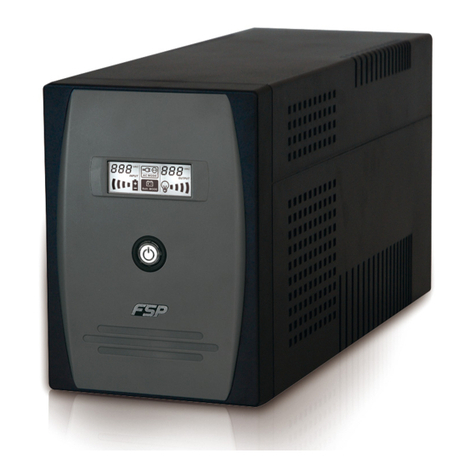
FSP Technology
FSP Technology EP 1500 Series quick guide

WÄRTSILÄ
WÄRTSILÄ JOVYATLAS POWERMASTER S 6000-P operating manual

FRIEDHELM LOH
FRIEDHELM LOH RITTAL DK 7857.440 Installation
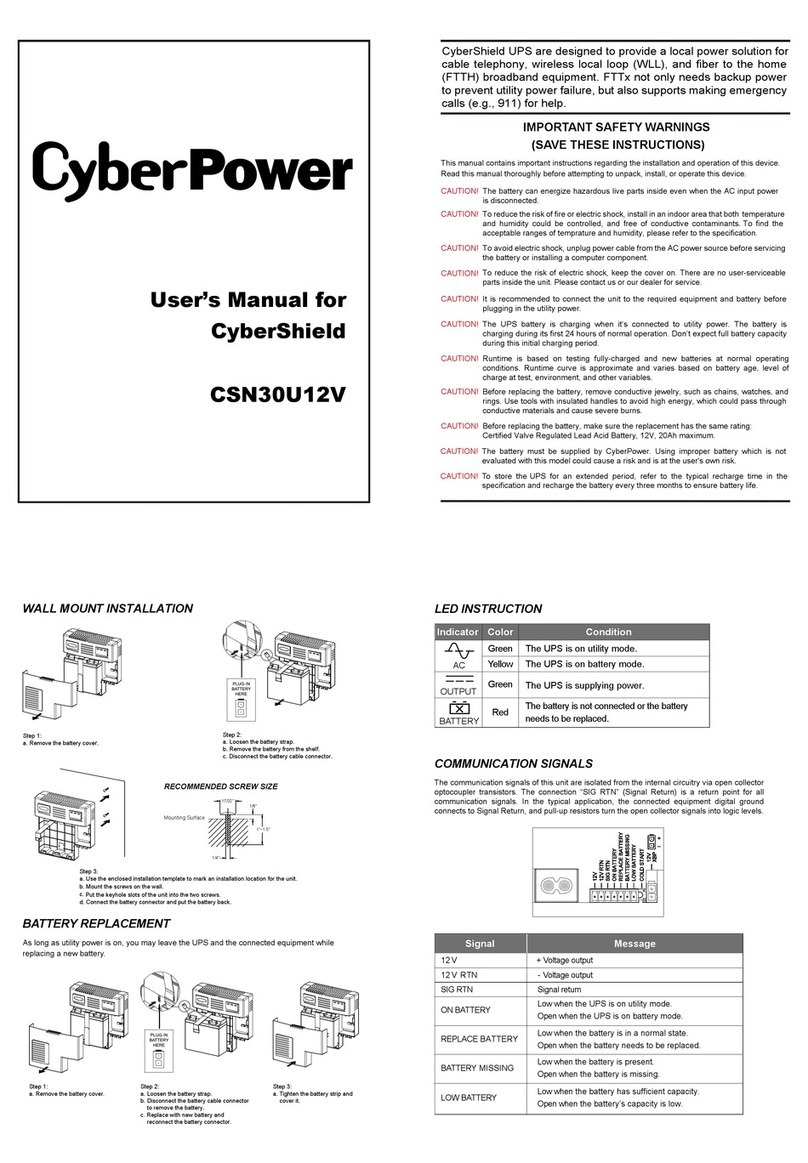
CyberPower
CyberPower CyberShield CSN30U12V user manual
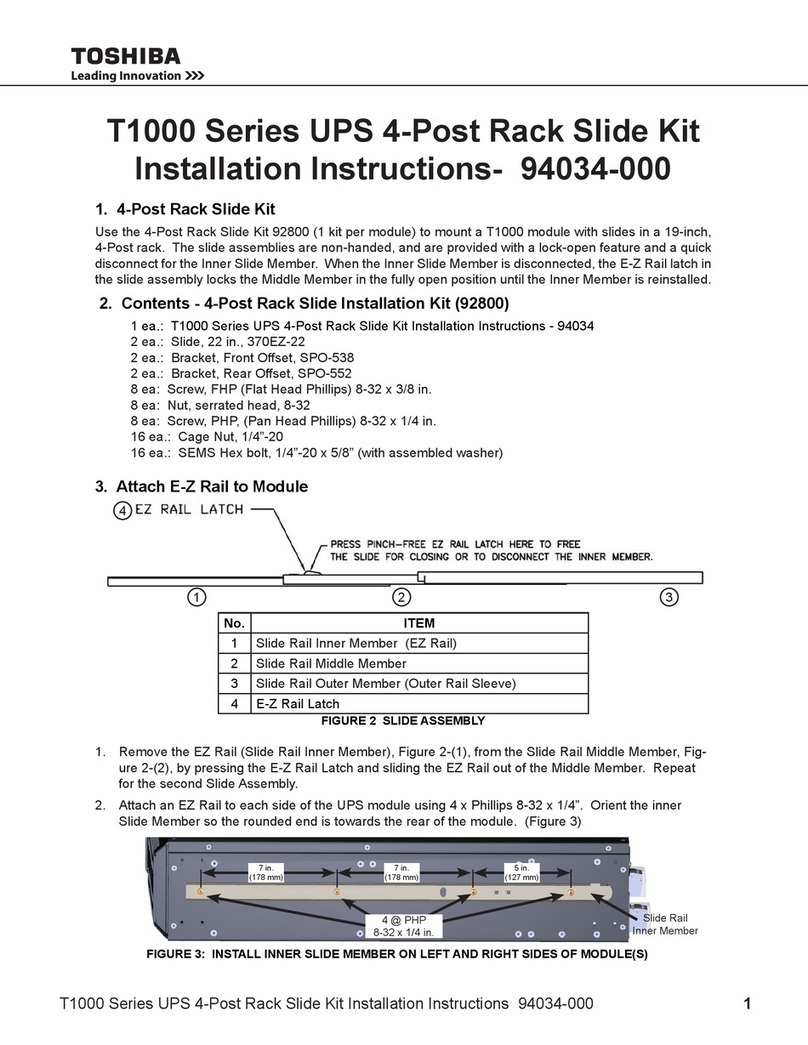
Toshiba
Toshiba T1000 Series installation instructions

socomec
socomec Green Power 2.0 60 Installation and operating manual
